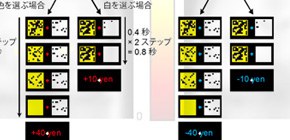
Elucidation of brain mechanism in gain–loss asymmetry in temporal discounting
Humans tend to perceive future gains as less valuable than equivalent gains in the present
A group of researchers at the Institute of Social and Economic Research, Osaka University, have clarified the brain mechanism of gain–loss asymmetry in temporal "discounting."
TANAKA Saori , formerly, Associate Professor, Institute of Social and Economic Research, Osaka University (currently, Advanced Telecommunications Research Institute International)
YAMADA Katsunori , formerly, Lecturer, Institute of Social and Economic Research, Osaka University (currently, Kinki University)
OHTAKE Fumio , Professor, Institute of Social and Economic Research, Osaka University
Modern economic research has pointed out the relationship between the sign effect and social problems such as obesity and the holding of multiple debts. This group's achievement will be helpful from the brain science viewpoint in preventing and solving such problems.
Humans tend to perceive future gains as less valuable than equivalent gains in the present. This tendency is called "time discounting." It is also known that future gains are "discounted" significantly more than future losses. For example, people perceive the value of 10,000 yen to be received in a month greater than the loss of an equal amount in a month. In economics, this gain-loss asymmetry is referred to as the "sign effect"; however, not all subjects exhibit such gain-loss asymmetry. Recently the sign effect has been shown to be associated with obesity, smoking, and incurring multiple debts; however, the neural mechanisms behind the sign effect have not been clarified.
In order to elucidate the mechanisms behind the sign effect, this group examined participants performing intertemporal choice tasks in which they had to choose a smaller-sooner reward or a larger-later reward and estimate their time discounting of rewards and losses. This research group compared the brain activity of a group exhibiting the sign effect with a group that did not exhibit the sign effect by fMRI and found differences in brain activity regarding loss. Specifically, regarding future losses, significant differences were apparent between the two participant groups in terms of striatal activity representing delay length and in insular activity representing sensitivity to magnitude; however, regarding future rewards, there were no differences in brain activity between both groups.
When comparing the brain activity pattern of rewards with that of losses, while groups exhibiting the sign effect showed a greater insular response to the magnitude of loss than to that of gain, and also a greater striatal response to the delay of loss than to that of gain, the group not exhibiting the sign effect did not show such patterns. These results suggest the lack of excessive reaction to losses in the brain activity is a possible cause of the lack of sign effect.
Abstract
Humans typically discount future gains more than losses. This phenomenon is referred to as the “sign effect” in experimental and behavioral economics. Although recent studies have reported associations between the sign effect and important social problems, such as obesity and incurring multiple debts, the biological basis for this phenomenon remains poorly understood.Here, we hypothesized that enhanced loss-related neural processing in magnitude and/or delay representation are causes of the sign effect. We examined participants performing intertemporal choice tasks involving future gains or losses and compared the brain activity of those who exhibited the sign effect and those who did not. When predicting future losses, significant differences were apparent between the two participant groups in terms of striatal activity representing delay length and in insular activity representing sensitivity to magnitude. Furthermore, participants with the sign effect exhibited a greater insular response to the magnitude of loss than to that of gain, and also a greater striatal response to the delay of loss than to that of gain. These findings may provide a new biological perspective for the development of novel treatments and preventive measures for social problems associated with the sign effect.

Figure 1

Figure 2

Figure 3
To learn more about this research, please read the full research report entitled " Neural Mechanisms of Gain–Loss Asymmetry in Temporal Discounting " at this page of The Journal of Neuroscience website.
Related link :
